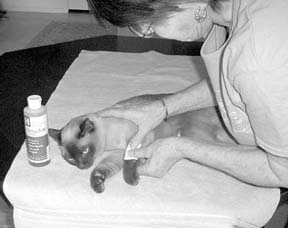Until you really know, you dont know, says Dr. Karl Jandrey, DVM, speaking on the need to medically evaluate and monitor your cat after an accident, even if it appears to be unharmed. A bruise on the abdomen may be the tip of the iceberg – it may be the only clinical clue for an internal hemorrhage, for example. Dr. Jandrey is a lecturer in small animal emergency and intensive care service for the University of California-Davis Veterinary Medical Teaching Hospital in Davis, California, and board certified by the American College of Veterinary Emergency and Critical Care.
Cats Hide Pain and Illness
According to Dr. Jandrey, cats are difficult to diagnose because they tend to hide their disease and injuries from owners. As a prey species, they dont want to show their injuries because it would make them the lowest on the totem pole in their pack.
What is the best way to proceed in the event your cat has an accident or an injury? Number one, says Dr. D. J. Krahwinkel, professor of surgery at the University of Tennessee College of Veterinary Medicine, be very careful when approaching any hurt animal. It may bite anyone who tries to touch it, even its owner. Furthermore, advises Dr. Krahwinkel, who is also board certified by the American College of Veterinary Emergency and Critical Care, if the cat is lying still or not moving – do not move it. It might have a broken back. If you must transport it, gently slide it onto a rigid structure, such as a piece of plywood or cardboard.
If there are no fractures, most cats can be restrained by holding the scruff of the neck. You can also wrap the cat snugly in a towel covering its front legs and holding them against the body. Dr. Krahwinkel says that cats should not be muzzled.
Three Ways to Proceed
You can respond to an accident or injury on three levels, says Dr. Krahwinkel.
Level one represents immediate danger. If the cat shows any signs of distress, says Dr. Krahwinkel, such as difficulty breathing, blood from any orifice or wound (eg, nose, mouth, anus), or loss of consciousness – take it to the veterinarian as quickly as possible. Dr. Jandrey agrees, and includes fractures, inability to walk or bear any weight or unresponsiveness.

288
Level two is a situation that requires monitoring. If the cat does not appear to be in grave distress, monitor it closely for progressive changes in clinical signs. If, over the next couple of hours, you see a progression of clinical signs, says Dr. Jandrey, this could indicate internal bleeding or swelling, due to a lung or brain injury. Look for developments such as a decreased level of awareness, loss of appetite, vomiting, changes in stool (i.e. blood, mucus), changes in gait (such as staggering or wobbliness), or breathing faster, in short, choppy breaths. If you observe any of these changes, dont hesitate to take a trip to the veterinarian.
Monitoring needs to continue even if you bring the cat to be checked out, says Dr. Jandrey. The animal may have a relatively normal exam and X-ray, but underlying problems may become more evident in the next 12 to 24 hours. It is extremely common for cats to have internal injuries. Monitoring should continue for 48 hours, advises Dr. Jandrey.
Level three involves minor injuries. If the cat is walking around looking bright, says Dr. Krahwinkel, then damage may be minor. He advises to check the following:
Gums: they should be pink, not pale;
Respiration: normal versus rapid or labored;
Pulse: strong versus weak – use the upper inside of a rear leg. Normal pulse rate for cats is between 150 and 200 beats per minute;
Temperature: should be between 100 to 102.5 degrees.
Not An Emergency, But …
What if a minor injury occurs after your veterinarians regular business hours? Says Dr. Krahwinkel, Call your veterinarian if you observe a couple of bouts of vomiting, diarrhea, itching, chewing (not mutilating) skin, missing one or two meals, limping or minor loss of blood. Watch their progress and seek veterinary attention if they do not improve by the next day.



